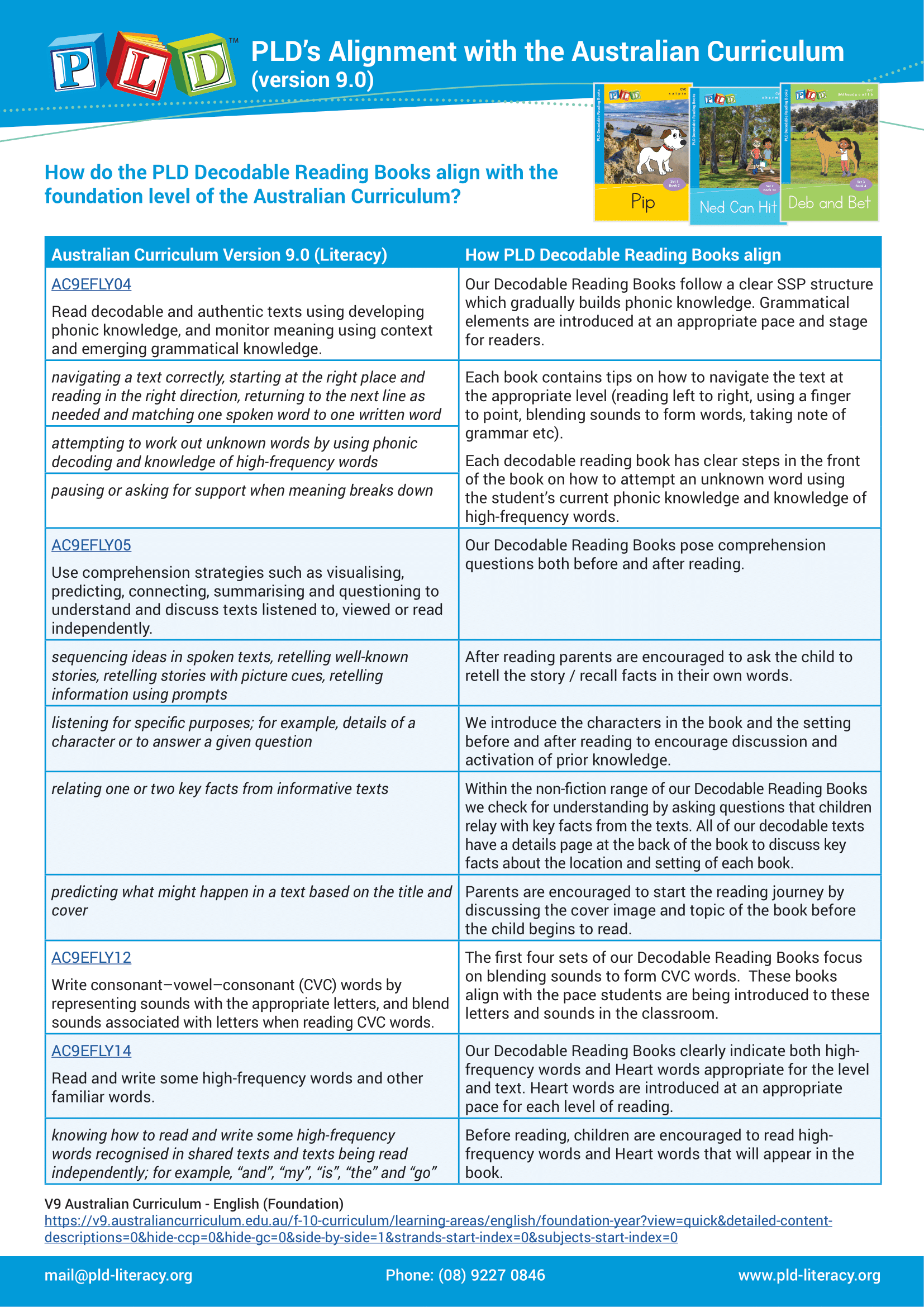PLD’s Foundation Decodable Reading Books
PLD Decodable reading books are designed for children being taught to read using Structured Synthetic phonics (SSP). These books present phonics and high-frequency words in a sequential order, enabling early readers to apply the phonics they are learning in the classroom to their reading practise.
PLD Decodable Reading Books are aligned with the Science of Reading and help students to build the right reading strategies. They necessitate the utilisation of decoding skills rather than guessing what the words say based on pictures or guessing from other cues.
Explore PLD’s Decodable Reading Books for Year 1 here.
Navigate to the relevant sections using the tabs below:
Stage 1 Target 1 CVC Set 5 & 6
Stage 1 Target 2 & 3 Set 7
Stage 1 Target 4 Decodable Reading
Book Bundles Decodable Reading
Books Downloads
Save 15% with PLD’s Programs Bundles!
Make your literacy budget go further with PLD’s expertly curated Program Bundles. Each bundle includes everything you need to support effective literacy instruction – designed to save you time, reduce planning, and improve student outcomes.
Why choose PLD Bundles?
– Comprehensive, research-backed resources
– Classroom-ready materials
– 15% savings when you bundle up!


At PLD, we also carefully curate a range of additional high-quality decodable reading books that align with Foundation SSP Teaching Sequence, allowing you to stock your classroom with a wide-range of decodable reading material.
Decodable Book for Semester 1 Featuring VC and CVC Words





Decodable Books for Semester 2 Featuring CVC, CCVC, and CVCC Words









FAQs for Teachers
- Can you offer guidance for the comprehension question picture book program?
- Do you have content available for our parent workshop?
- Can you assist with our early reading parent workshop?
- Do you offer information directly to parents?
FAQs for Parents
My child’s school uses PLD programs and decodable reading books. Who is PLD?
PLD stands for Promoting Literacy Development.
PLD is an evidence-based Australian literacy program designed to develop your child’s reading and writing skills.
What is phonics and why is it important?
Phonics teaches your child that speech sounds are represented by letters or groups of letters, enabling your child to read and spell words. If your child knows the letter or letters that represent the sounds in words they are able to sound out words while reading and spell words accurately while writing.
How is synthetic phonics different to levelled reading books?
In synthetic phonics your child is encouraged to sound out unknown words e.g., ‘net’ is broken up into its sounds /n/ /e/ /t/ and then read as a whole word /net/. Remember to prompt your child to add a finger tracking underneath the letters n-e-t as they say the sounds.
Levelled reading books on the other hand encourage children to guess the word based on a picture clue and rote learn books from memorisation rather than reading each word.
What are decodable reading books and why are they important?
Your child’s teacher will gradually teach groups of letters to the class. Decodable reading books only use the sounds your child knows so that they can successfully read the book provided to you. Decodable reading books allow for your child to practise the letter-sounds taught within the context of a book with words and sentences. Repeated practice of decodable reading material will eventually lead to fast automatic reading.
What do parents do when working with decodable reading books at home?
1. Review the sounds presented in the book, does your child know all the sounds presented on page 1?
2. Read the words on page 1 as a warm up. Help your child when they get stuck by asking them to say the sounds in the word or help them by stretching the word out e.g., /mmmmeeet/ “what’s the word?” ‘Met’.
3. Read the Heart words on page 1. Tell them the word if they are unsure.
Start reading together. Ask your child to track underneath each word or letter using their pointer finger. Refer to the ‘tips to help early readers’ section on page 2 to support your child if they are struggling.
How do I help my child when they get stuck on a word?
For some children reading is easy, however some children will find reading difficult. When your child gets stuck on a word try these strategies to help your child read the words:
1. Ask your child to say each sound and listen to hear the word.
2. If they are still unable to read the word, ask your child to listen as you say the word one sound at a time and they put it together to form a whole word.
3. If your child is still unsure of the word, stretch out the word e.g., /mmmaaaat/ and if they are still unable to read the word, provide the word for them.
What if my child is reading every word slowly and sounding out every word?
Reading slowly and sounding out each word even when it comes up multiple times in a text is normal when your child is first learning to read. Some children will need to read a word only a few times before it is automatically and quickly read, for others it may need to be hundreds of times before they can read the words without sounding them out.
What else can I do to support my child’s reading?
Engage in shared book reading with children’s picture books to foster language development and enhance their listening comprehension. Repeated readings of the same book, coupled with discussion and comprehension questions can deepen understanding and enjoyment around book reading.
Ask your school to provide you with PLD’s Comprehension Questions resource for your child to be provided with a list of children’s books and their accompanying comprehension questions.


































